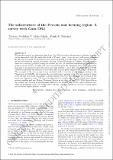Files in this item
The substructure of the Perseus star forming region : a survey with Gaia DR2
Item metadata
| dc.contributor.author | Pavlidou, Tatiana | |
| dc.contributor.author | Scholz, Aleks | |
| dc.contributor.author | Teixeira, Paula S | |
| dc.date.accessioned | 2021-02-22T16:30:18Z | |
| dc.date.available | 2021-02-22T16:30:18Z | |
| dc.date.issued | 2021-05 | |
| dc.identifier | 273008468 | |
| dc.identifier | 63066f89-54fe-400c-8ac6-679fc7a710b4 | |
| dc.identifier | 000649000600008 | |
| dc.identifier | 85113464775 | |
| dc.identifier.citation | Pavlidou , T , Scholz , A & Teixeira , P S 2021 , ' The substructure of the Perseus star forming region : a survey with Gaia DR2 ' , Monthly Notices of the Royal Astronomical Society , vol. 503 , no. 3 , pp. 3232–3242 . https://doi.org/10.1093/mnras/stab352 | en |
| dc.identifier.issn | 0035-8711 | |
| dc.identifier.other | Jisc: 282e56195aff473784df375a80ba5f8c | |
| dc.identifier.other | ORCID: /0000-0002-3665-5784/work/89628245 | |
| dc.identifier.uri | https://hdl.handle.net/10023/21480 | |
| dc.description | This project was supported by STFC grant ST/R000824/1. | en |
| dc.description.abstract | We use photometric and kinematic data from Gaia DR2 to explore the structure of the star forming region associated with the molecular cloud of Perseus. Apart from the two well known clusters, IC 348 and NGC 1333, we present five new clustered groups of young stars, which contain between 30 and 300 members, named Autochthe, Alcaeus, Heleus, Electryon and Mestor. We demonstrate these are co-moving groups of young stars, based on how the candidate members are distributed in position, proper motion, parallax and colour-magnitude space. By comparing their colour-magnitude diagrams to isochrones we show that they have ages between 1 and 5 Myr. Using 2MASS and WISE colours we find that the fraction of stars with discs in each group ranges from 10 to ∼50 percent. The youngest of the new groups is also associated with a reservoir of cold dust, according to the Planck map at 353 GHz. We compare the ages and proper motions of the five new groups to those of IC 348 and NGC 1333. Autochthe is clearly linked with NGC 1333 and may have formed in the same star formation event. The seven groups separate roughly into two sets which share proper motion, parallax and age: Heleus, Electryon, Mestor as the older set, and NGC 1333, Autochthe as the younger set. Alcaeus is kinematically related to the younger set, but at a more advanced age, while the properties of IC 348 overlap with both sets. All older groups in this star forming region are located at higher galactic latitude. | |
| dc.format.extent | 4534515 | |
| dc.language.iso | eng | |
| dc.relation.ispartof | Monthly Notices of the Royal Astronomical Society | en |
| dc.subject | Galaxies: star clusters: general | en |
| dc.subject | Stars: formation | en |
| dc.subject | Methods: observational | en |
| dc.subject | QB Astronomy | en |
| dc.subject | QC Physics | en |
| dc.subject | DAS | en |
| dc.subject.lcc | QB | en |
| dc.subject.lcc | QC | en |
| dc.title | The substructure of the Perseus star forming region : a survey with Gaia DR2 | en |
| dc.type | Journal article | en |
| dc.contributor.sponsor | Science & Technology Facilities Council | en |
| dc.contributor.institution | University of St Andrews. School of Physics and Astronomy | en |
| dc.contributor.institution | University of St Andrews. St Andrews Centre for Exoplanet Science | en |
| dc.identifier.doi | https://doi.org/10.1093/mnras/stab352 | |
| dc.description.status | Peer reviewed | en |
| dc.identifier.grantnumber | ST/R00824/1 | en |
This item appears in the following Collection(s)
Items in the St Andrews Research Repository are protected by copyright, with all rights reserved, unless otherwise indicated.

